Tachypneic - Study guides, Class notes & Summaries
Looking for the best study guides, study notes and summaries about Tachypneic? On this page you'll find 2502 study documents about Tachypneic.
All 2.502 results
Sort by
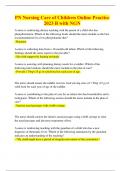 Popular
Popular
-
PN Nursing Care of Children Online Practice 2023 B with NGN, Answered
- Exam (elaborations) • 12 pages • 2023
- Available in package deal
-
- $9.04
- 5x sold
- + learn more
PN Nursing Care of Children Online Practice 2023 B with NGN, Answered-A nurse is reinforcing dietary teaching with the parent of a child who has phenylketonuria. Which of the following foods should the nurse include as the best recommendation for a low phenylalanine diet? - Bananna A nurse is collecting data from a 10-month-old infant. Which of the following findings should the nurse report to the provider? - Sits with support by leaning on hands A nurse is assisting with planning diet...
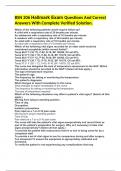 Popular
Popular
-
BSN 206 Hallmark Exam Questions And Correct Answers With Complete Verified Solution.
- Exam (elaborations) • 76 pages • 2024 Popular
-
- $16.09
- 3x sold
- + learn more
BSN 206 Hallmark Exam Questions And Correct Answers With Complete Verified Solution. Which of the following patients would require follow-up? A child with a respiratory rate of 20 breaths per minute. An adolescent with a respiratory rate of 16 breaths per minute. A newborn with a respiratory rate of 40 breaths per minute. An adult with a respiratory rate of 10 breaths per minute. An adult with a respiratory rate of 10 breaths per minute Which of the following vital signs recorded for an...
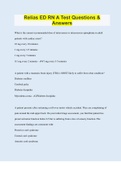
-
Relias ED RN A Test Questions & Answers | 70 Questions with 100% Correct Answers | Verified | Updated 2023 | 23 Pages
- Exam (elaborations) • 23 pages • 2023
- Available in package deal
-
- $12.49
- 21x sold
- + learn more
What is the current recommended dose of intravenous or intraosseous epinephrine in adult patients with cardiac arrest? 10 mg every 10 minutes 1 mg every 3-5 minutes 1 mg every 7 minutes 0.1 mg every 2 minutes - 1 mg every 3-5 minutes A patient with a traumatic brain injury (TBI) is MOST likely to suffer from what condition? Diabetes mellitus Cerebral palsy Diabetes Insipidus Myxedema coma - Diabetes Insipidus A patient presents after sustaining a roll-over motor vehicle accident. They...
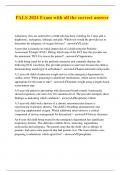
-
PALS 2024 Exam with all the correct answer
- Exam (elaborations) • 7 pages • 2024
- Available in package deal
-
- $11.49
- 2x sold
- + learn more
PALS 2024 Exam with all the correct answer Laboratory tests are ordered for a child who has been vomiting for 3 days and is diaphoretic, tachypneic, lethargic and pale. Which test would the provider use to determine the adequacy of oxygen delivery? - answerLactate A provider is forming an initial impression of a child using the Pediatric Assessment Triangle (PAT). During which step of the PAT may the provider use the mnemonic TICLS to assess the patient? - answerAppearance A child being c...

-
Relias ED RN A -Solved 100%
- Exam (elaborations) • 18 pages • 2023
-
- $18.49
- 2x sold
- + learn more
Relias ED RN A What is the current recommended dose of intravenous or intraosseous epinephrine in adult patients with cardiac arrest? 10 mg every 10 minutes 1 mg every 3-5 minutes 1 mg every 7 minutes 0.1 mg every 2 minutes 1 mg every 3-5 minutes A patient with a traumatic brain injury (TBI) is MOST likely to suffer from what condition? Diabetes mellitus Cerebral palsy Diabetes Insipidus Myxedema coma Diabetes Insipidus A patient presents after sustaining a roll-over motor vehicle...
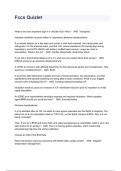
-
FCCS (Fundamentals of Critical Care Support) Exam – Questions And Answers
- Exam (elaborations) • 34 pages • 2023
-
- $13.49
- 2x sold
- + learn more
FCCS (Fundamentals of Critical Care Support) Exam – Questions And Answers What is the most important sign in a critically ill pt? Why? - ANS Tachypnea Indicates metabolic acidosis (often w/ respiratory alkalosis compensation) A pt misses dialysis for a few days and comes in with fluid overload. He's tachycardic and tachypneic. On the physical exam, you find JVD, pulsus paradoxus (20 mmHg drop during inspiration), and HoTN (80/40) with distant, muffled heart sounds. Lungs are clear to...
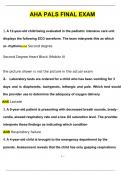
-
AHA PALS FINAL EXAM 2024 Questions and Verified Answers (2024 / 2025)/ A+ GRADE
- Exam (elaborations) • 17 pages • 2024
- Available in package deal
-
- $15.49
- 1x sold
- + learn more
AHA PALS FINAL EXAM 2024 Questions and Verified Answers (2024 / 2025)/ A+ GRADE.1. A 12-year-old child being evaluated in the pediatric intensive care unit displays the following ECG waveform. The team interprets this as which ar- rhythmia ANS Second degree Second Degree Heart Block (Mobitz II) the picture shown is not the picture in the actual exam 2. Laboratory tests are ordered for a child who has been vomiting for 3 days and is diaphoretic, tachypneic, lethargic and pale. Which test wo...
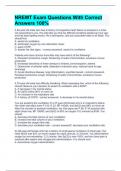
-
NREMT Exam Questions With Correct Answers 100% correct 2023/2024
- Exam (elaborations) • 22 pages • 2023
- Available in package deal
-
- $13.49
- 1x sold
- + learn more
NREMT Exam Questions With Correct Answers 100% correct 2023/2024A 65-year-old male who has a history of congestive heart failure is slumped in a chair not responding to you. His wife tells you that his difficulty breathing started an hour ago and has been getting worse. He is tachypneic, and you auscultate rales in all fields. You should first: A. assist his ventilation. B. administer oxygen by non-rebreather mask. C. apply CPAP. D. assess his vital signs. - correct answersA. assist his vent...
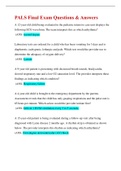
-
PALS Final Exam; 50 Questions & Answers;Latest Solution/ 100%Verified;PALS Final Exam (Actual Exam)
- Exam (elaborations) • 12 pages • 2022
- Available in package deal
-
- $8.00
- 106x sold
- + learn more
A 12-year-old child being evaluated in the pediatric intensive care unit displays the following ECG waveform. The team interprets this as which arrhythmia? (ANS- second degree Laboratory tests are ordered for a child who has been vomiting for 3 days and is diaphoretic, tachypneic, lethargic and pale. Which test would the provider use to determine the adequacy of oxygen delivery? (ANS- Lactate A 9-year-old patient is presenting with decreased breath sounds, bradycardia, slowed respiratory r...
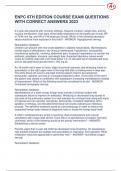
-
ENPC 6th Edition Course Exam 2023 with 100% correct answers
- Exam (elaborations) • 8 pages • 2023
-
- $14.99
- 1x sold
- + learn more
A 4-year-old presents with vomiting, lethargy, frequent urination, weight loss, and dry mucous membranes. Vital signs reveal deep respirations at 44 breaths per minute, BP of 70/44 mm Hg, and HR of 144 beats per minute. Which of the following laboratory values would be most expected in this child? - correct answer -Hypoglycemia (wrong) Remediation feedback: Children can present with new onset diabetes in diabetic ketoacidosis. Manifestations include signs of dehydration ( dry mucous membranes, h...
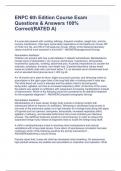
-
ENPC 6th Edition Course Exam Questions & Answers 100% Correct(RATED A)
- Exam (elaborations) • 8 pages • 2023
- Available in package deal
-
- $10.49
- 10x sold
- + learn more
A 4-year-old presents with vomiting, lethargy, frequent urination, weight loss, and dry mucous membranes. Vital signs reveal deep respirations at 44 breaths per minute, BP of 70/44 mm Hg, and HR of 144 beats per minute. Which of the following laboratory values would be most expected in this child? - ANSWERHypoglycemia (wrong) Remediation feedback: Children can present with new onset diabetes in diabetic ketoacidosis. Manifestations include signs of dehydration ( dry mucous membranes, hypoten...

$6.50 for your textbook summary multiplied by 100 fellow students... Do the math: that's a lot of money! Don't be a thief of your own wallet and start uploading yours now. Discover all about earning on Stuvia


